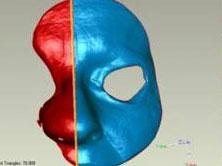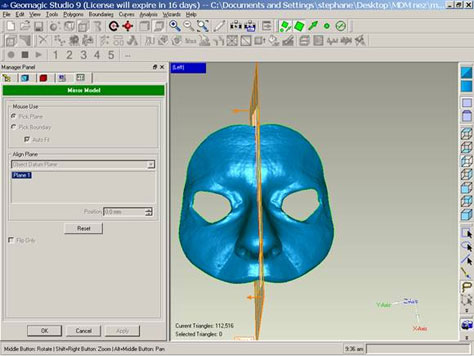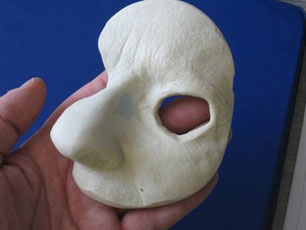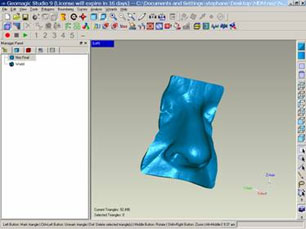Case history
A patient had to undergo the surgical ablation of most of her nose because of a skin cancer that had attacked her right nasal septum.
Following the surgery, a cicatrization period had to be observed before a rhinoplasty was even considered. If no action was taken meanwhile, the patient was at risk of tissue sagging or permanent deformation of the surrounding tissues – which might not be repairable by plastic surgery.
Beyond biological considerations, the psychological after-effects of such procedure on the patient self-esteem and social reintegration had to be measured and taken into account. This body part, more than any other, enables a human being to identify and define himself in relation to his fellow men. There was never a doubt that such a prosthesis was of the utmost importance. After careful consideration of all of these factors, the treating physician ordered the manufacturing of a prosthesis perfectly adapted to the patient’s face. However, cancer being a fast-progression disease and available ORs being scarce, it was essential to find a fast and effective manufacturing method. This is when Creaform’s expertise in 3D scanning was called upon.
A transitory solution
Creaform, a world leader in portable 3D measurement technologies, has developed and sells the Handyscan 3D line-up of laser scanners. These revolutionary scanners allow the scanning of existing objects in order to generate digital files that can be modified and edited in various post-treatment software. Thanks to this state-of-the-art technology, it would be possible to create a well-adjusted, comfortable and natural-looking prosthesis.
The 1st step was to create a silicon moulding of the patient’s nose before the surgical ablation. The left half still being healthy, it would be used as a model to reproduce an identical and symmetrical half of the right side. This is a painless and non-traumatic process for the patient and requires very little time, aside from the silicone’s drying time.
An accurate digital imprint of the silicone mould had to be done, and this is when Creaform’s specialists came into play. The data from the silicone imprint were collected with the Handyscan 3D scanner in just under 10 minutes!
Half an hour to recreate half a nose
Once the 3D data from the mould were acquired and a .stl file was generated, Creaform’s CAD Department team used a post-treatment software to modify the digital model of the mould following the guidelines provided.
First, the right part of the nose (the part that was to be surgically removed) was deleted from the file and was replaced by the symmetrical image of the left half. The useless surfaces (the forehead, the outline of the eye and the cheek) were also deleted during that step. Finally, the 3D model was prepared for rapid prototyping by adding a thickness (during that process, a specialized machine “carves” an object in a given material from the information it acquires from a digital file). Using a pain-free method such as scanning, the patient was provided with a paintable prosthesis that was affixed to her face and that would prevent additional damage while waiting for the rhinoplasty. All in all, the process required about 30 minutes of work: such efficiency speaks for itself!
A versatile prosthesis
A prosthesis like that one offers numerous benefits, of which the possibility of using it as a model during the rhinoplasty or during the moulding process of elements that were to support the flesh and respiratory track during the intervention.
Technology for the well-being of people
Thanks to the precision and speed offered by the Handyscan 3D handheld and self-positioning 3D laser scanner and to the expertise of the Creaform people, it was possible to create a prosthesis for a cancer surviver in a very short timeline, without causing any delay in the procedure schedule and thus giving the patient the best chances for a quick and complete recovery. Moreover, this technology has the virtue of contributing to the self-esteem and well-being of sick people and enabling them to feel confident about their future.








